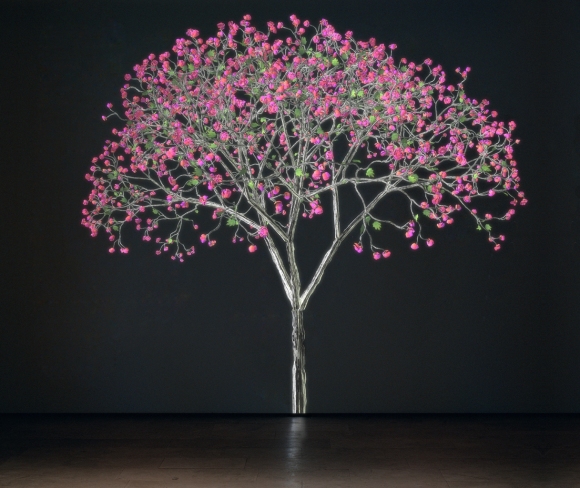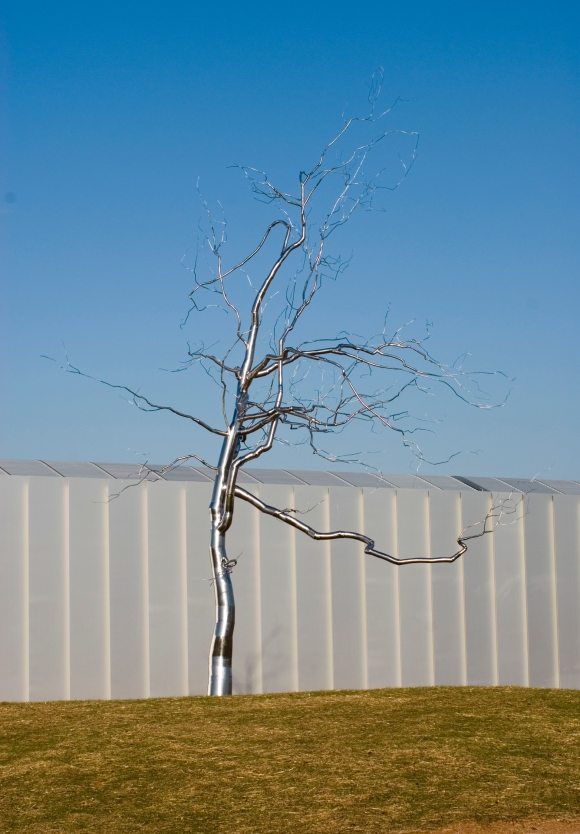Time Capsule #1 – Jennifer Steinkamp, “Mike Kelley” (Story)
By Camille Tewell
First—can we talk about the title of this piece? Usually I don’t like to start with the title when I discuss works of art with teachers (or with anyone, actually), but maybe let’s go ahead and deal with it. It’s a little confusing, right? I mean, who is the artist here?
This is an awesome work for teachers to be interested in because it is a work of art made by artist Jennifer Steinkamp in honor of her former teacher (also an artist), Mike Kelley. What do you think about the way in which she has honored him?
It might be difficult to answer that question if you haven’t seen this work of art at the Museum. Why? The image above is but a fragment of the actual work of art. Mike Kelley is an eight-minute video loop, projected in large scale on the wall in West Building. The “tree” branches sway and change in response to wind we can’t feel and two-minute pseudo-seasons that take it from the fullness of bloom (as seen above), to fall color, to bare arms, and then to bud and bloom again.
The thing is—the “tree” doesn’t move like any tree you’ve ever seen before. It moves like a sentient being. It writhes. Its tiniest branches expand and contract like tentacles reaching out to feel its surroundings. In the next moment, the entire form spirals tight into a ball of limbs then unwinds in the most unnatural (but beautiful) way. This “tree” is alive but make no mistake—it is not a thing of nature. Check out this video loop (of a different Mike Kelley) from Steinkamp’s website to get a sense of its movement.
Our outdoor sculpture Askew, by artist Roxy Paine—of a “dendroid,” not a tree—draws similar comparisons between manmade and natural things. I guess you could say that we like our artificial tree-like forms here at the Museum.
You could easily use either of these works to start a conversation about technology and art, man vs. nature, etc. (all important teaching threads)—but let’s go back to the title, Mike Kelley. By giving her work of art this title, Jennifer Steinkamp asks us to redirect our thinking.
Mike Kelley, as work of art, plows through “seasons” and “years” in record time through a digital form that can never die. Unlike our paintings on canvas, Steinkamp’s medium will not disintegrate or fade over time. The influence of her teacher, and his memory (he died in 2012), can live forever in the digital code of her animation. Yet to absorb her work of art in full, as viewers we are forced to sit or stand for eight minutes, which seems rather like a long time in comparison with the pace of today’s world. What does it mean to last forever? How long is “long”? What happens when we (as viewers, as people) slow down and pay close attention to the world around us?
Quick subject-area notes related to Mike Kelley and Time:
Science – lifecycles; nature vs. technology (then vs. now)
ELA – predicting what happens next; telling a story through images or time-lapse video
Dance – using movement and body forms to suggest natural cycles, personalities, or mood
Links:
http://www.pbs.org/art21/artists/mike-kelley
This is the first installment of Timecapsules, a micro-post series on the Big Picture concept of Time. Don’t miss our upcoming special exhibition exploring this theme through a variety of media, 0 to 60: The Experience of Time through Contemporary Art.


